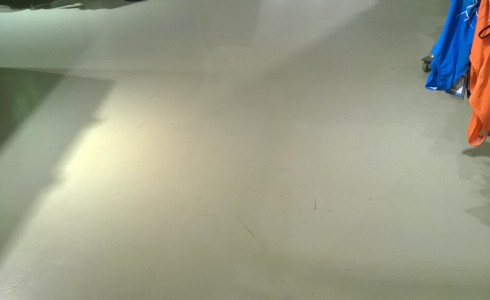DESCRIPTION AND FIELDS OF APPLICATION
Solvent-free two-component epoxy system with aliphatic cycle hardener for making self-levelling/multilayer protective coatings of indoor concrete floors subject to foot and wheeled vehicle traffic.
MAIN FEATURES
Solvent-free system that can be easily used indoors, its viscosity allows its use with different laying methods, self-levelling, trowel, roller. Glossy/satin finish with good mechanical and chemical resistance. Reaches maximum strength upon completion of curing, approx. 8 days after application under normal conditions.
APPLICATION DATA
The substrate must be clean, free of substances that hinder the adhesion of the system (waxes, silicones, oily traces), compact and very important dry. The presence of water in the pavement, without appropriate pre-treatment, can cause the coating to detach. New cementitious substrates must be cured min. 30 days. Smooth surfaces, with traces of absorbed oil, with previous coatings must be suitably roughened by mechanical intervention (shot peening, abrasion, etc.); with previous coatings check their adhesion to the substrate.
To promote adhesion always preliminarily apply DUALENE EPX MS (see technical data sheet), with quartz dusting, and within 24 h (at 20°C), spread the epoxy system in the intended application method. When layering successive coats, always adhere to the maximum time frame indicated. Base product and hardener should be mechanically mixed before use, and always under stirring add any filler as required by use. Multilayer system up to 1 mm thickness. On the substrate previously treated with DUALENE EPX MS, vacuum the quartz from the dusting, sand the surface (80/100 grit paper), and vacuum off the residue; spread 1 coat with a medium-haired roller of the epoxy system, crisscrossing the rolls. Multilayer system up to 3 mm thickness.
On the substrate previously treated with DUALENE EPX MS, vacuum off the quartz from the dusting, spread with metal trowel the epoxy system mixed with 0.5 mm quartz in the ratio 1 : 0.5, then on the fresh layer proceed to dust with 0.5 mm quartz, until completely covered. When completely dry, vacuum off the quartz from the dusting, sand the surface (80/100 grit paper), and vacuum off the residue. Spread a layer of epoxy system, without added filler, by metal trowel by recoating the fresh product with a short-haired roller, crisscrossing the rolls. The cycles described are moderately rough, thus having an anti-slip characteristic and consequent increased dirt pickup.
For a smoother surface, use 03 mm quartz for filler and dusting (in the former case with DUALENE EPX MS; in the latter in the epoxy system). Self-levelling system up to 2 mm thickness. On the substrate previously treated with DUALENE EPX MS, vacuum the quartz from the dusting coat. Mix the epoxy system and add 03 mm quartz up to max. 1 : 1.
Spread the loaded mixture, tipping it on the substrate while helping the spreading with a trowel, immediately go over the surface with a bubble breaker roller. To work on surfaces already coated with fresh product, use metal crampons. In the cycles described, the indicated filler amounts and grain sizes may vary. In self-leveling systems as the amount of filler increases, the leveling capacity of the system may be reduced.
The greater the amount of catalyzed system, the lower the pot-life of the mixture, especially in hot weather it is advisable to reduce the catalyzed amounts, so it is essential to have a scale on site to comply with the catalysis ratios. Store the system components in optimal temperature conditions (in a heated room in the winter season, in the shade in the summer season), to avoid application problems due to viscosity variation or excessive reduction in pot-life When over-applying between layers, operate within max. 24 h at 22°C, so as not to compromise adhesion.
Regardless of the application system adopted, wait at least 24/36 h under normal conditions before operation. Operate at temperatures between 15-30°C, including of the substrate (at T below 10°C, catalysis is not complete), and with R.H. < 80%. For the final layer, use product from the same batch to avoid possible slight color differences. Wash tools with thinner (nitro, for epoxy), or ethyl alcohol immediately after use.
YIELD
Yield varies depending on the type of substrate, its roughness and the type of finish. Multilayer system up to 1 mm thickness 0.4÷0.6 kg/m2 Multilayer system up to 3 mm thickness Filler layer (mixture ratio epoxy system/quartz 1:0.5): 1 kg/m2 corresponding to 0.7 kg of epoxy system Finish layer (unfilled system): 0.6 kg/m2 For dusting consider a consumption of approx. kg/m2, regardless of the grain size used. Self-levelling system up to 2 mm thickness Epoxy system/quartz mixture ratio 1:0.8: 1.7 kg/m2/mm corresponding to 1 kg of epoxy system (for 2 mm total, 2 kg/m2 ) To evaluate yields more accurately depending on the type of use, thicknesses and the roughness of the substrate, carry out tests beforehand.
TECHNICAL DATA
(mixture) Catalysis ratio Ind./P Base 100/31,3 (76/24)
Density .4 kg/L
Shore hardness D (10 days 20°C) 85
Pot life (125 g at 25°C) 30-40 min.
Hardening at 22°C
- to touch 3 h
- complete 8 days
- Walkability min.24/36 h with caution
Abrasion resistance (UNI EN ISO 7784-2 – CS 10 – 1 kg) 1000 rpm < 80 mg
Stability in original packaging min 12 months


